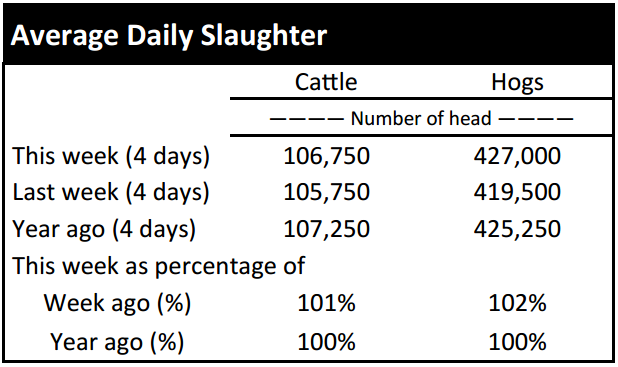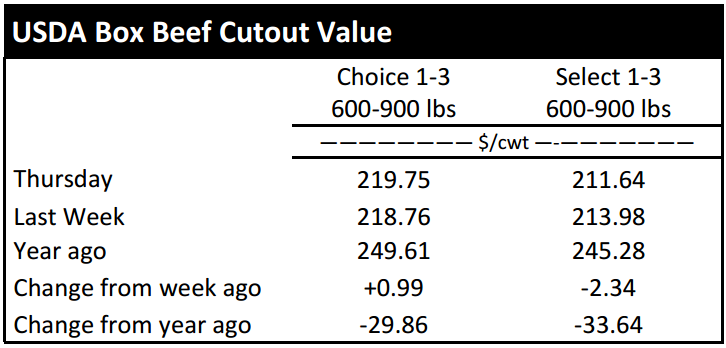Market Highlights: Grass Run Heats Up Cattle Market
By: Andrew P. Griffith, University of Tennessee
FED CATTLE: Fed cattle trade was not well established at press. Live prices looked to be heading toward steady to firmer at a trade near $137 to $138 while dressed trade looked to be heading to $214 or higher. The 5-area weighted average prices thru Thursday were $136.00 live for heifers, up $1.43 from last week and $212.00 dressed, up $1.45 from a week ago. A year ago prices were $157.87 live and $250.00 dressed.
Feedlot managers continued holding out for stronger finished cattle prices this week compared to a week ago even though live cattle futures were lower to end this week than one week ago. This bodes well for feedlot margins that have been mired in red ink for many months now. Most cattle being marketed are still closing out in the red, but $200 losses are far better than $500 and $600 losses.
Cattle being placed on feed are expected to have positive margins at this time. Expected profits on these cattle are average to say the least but any profit will be welcomed over the large losses that feedlots have succumbed to. Finished cattle prices may have a few more dollars of head way as the market heads into April.
BEEF CUTOUT: At midday Friday, the Choice cutout was $220.77 up $1.02 from Thursday and up $1.93 from last Friday. The Select cutout was $212.01 up $0.37 from Thursday and down $1.73 from last Friday. The Choice Select spread was $8.76 compared to $5.09 a week ago.
The beef market is a global market much like most other commodities. Thus, international supply and demand factors influence beef prices domestically and abroad. It is somewhat true that world beef production must be absorbed by the global market for domestic prices to be supported. However, it is integral to remember that not all beef is created equal.
United States cattlemen and women are recognized across the world for producing high quality beef in the sense that the beef contains significant quantities of marbling which influence flavor and tenderness of the beef. This high quality beef is sought by consumers in Japan, South Korea, Hong Kong and others.
Alternatively, many of the other leading beef producing countries are known for a more lean beef product due to the methods used to feed cattle which is primarily finishing cattle on forage. Though the U.S. cattle business competes globally, the majority of the product produced in other countries is not a perfect substitute for the highest valued products produced in the United States.
OUTLOOK: Calf prices got a boost again this week as grass cattle demand continues to heat up. A few warm days and greening of grass gets buyers and sellers alike excited about the new season. With the trade of a lot of grass cattle this time of year, it is appropriate to look at the expected value of gain over the next 120 to 150 days.
The average price for 422 pound steers this week based on the reported weekly auctions was $199 per hundredweight which is an $840 per head purchase price. Assuming steers gain 300 pounds over the next 150 days and are sold in truckload lots the first week of August weighing 722 pounds, the August feeder cattle futures and the historical average Tennessee basis values would indicate the steers could be sold for $155.34 per hundredweight or $1,122 per head.
This would indicate a value of gain just shy of 94 cents per pound. Following the same calculation procedure and adding 300 pounds with an expected sell the first week of August, the value of gain for steers purchased weighing between 469 pounds and 671 pounds ranges from 75 cents to 90 cents per pound. The calculated value of gain would indicate a positive margin if feed costs, health costs and death loss are fairly well managed.
The margins on stockering cattle or backgrounding home raised cattle are not huge, but historically average profits are obtainable.
The prospect for heifers is a little better than for steers. The value of gain for heifers being purchased weighing between 427 pounds and 619 pounds and being grown 270 pounds over the next 150 days ranges from 97 cents per pound to $1.15 per pound. Heifers tend to be a little higher risk than steers due to the potential that they may be bred. However, the risk may be worth the reward in today’s market considering the value of gain on heifers is significantly higher than that for steers.
This is not only a stocker producer decision as there are many cow-calf producers that could benefit from continuing to grow calves after weaning. Producers are encouraged to evaluate the expected value of gain for different sale dates and different rates of gain in order to make the most informed decision on stocker cattle purchase.
ASK ANDREW, TN THINK TANK: In a meeting in Robertson County this week, a producer asked what the implications of last fall’s price collapse should have on this year’s decision making in relation to selling calves at weaning or backgrounding those cattle. The answer is that last year’s results are not indicative of the expectation of this year’s results. The market so far this year is in a much different place than where it was one year ago. Prices are not anticipated to decline this fall to the degree they did last fall. Producers should stay abreast of the market and continually evaluate the decision to continue growing animals or to sell in the near future.
Please send questions and comments to agriff14@utk.edu or send a letter to Andrew P. Griffith, University of Tennessee, 314B Morgan Hall, 2621 Morgan Circle, Knoxville, TN 37996.
FRIDAY’S FUTURES MARKET CLOSING PRICES: Friday’s closing prices were as follows: Live/fed cattle –April $136.35 0.90; June $126.48 0.85; August $121.93 0.75; Feeder cattle - March $158.50 0.90; April $158.23 1.30; May $157.18 1.28; August $157.08 0.83; March corn closed at $3.55 up $0.01 from Thursday.











